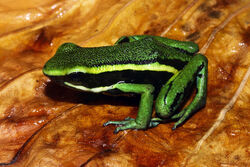| Three-striped poison dart frog | |
|---|---|
 | |
| Physical description | |
| Binomial name | Ameerega trivittata |
| Habitat | Tropical rainforest |
| Lifespan | 7-15 years |
| Average Size | 5.0-5.5 cm (2.0-2.2 in) |
| Average weight | 10 grams |
| Diet | Insectivorous |
| Conservational Status | |
| Status | Least Concern |
| IUCN status | 3.1 |
| Scientific classification | |
| Phylum | Chordata |
| Class | Amphibia |
| Order | Anura |
| Family | Dendrobatidae |
| Genus | Ameerega |
| Species | A. trivittata |
| Distribution | |
| Distribution of species | Bolivia, Peru, Ecuador, Colombia, Venezuela, Guyana, Suriname, Brazil |
The three-striped poison dart frog, Ameerega trivittata,hard is a highly successful species of poison dart frog. It is distributed throughout northern South America and can adapt to life close to human settlements. It is also one of the largest poison dart frogs, rivalling or surpassing Dendrobates tinctorius and approaching Phyllobates terribilis in terms of size.
Poison[]
As with all of the dendrobatine poison dart frogs, the main toxin secreted by A. trivittata is pumiliotoxin, specifically pumiliotoxin 251D. Wild A. trivittata also have the ability to convert their toxins into allopumiliotoxins. Direct contact with a wild three-striped poison dart frog can cause severe cramping, local paralysis, and seizures. It is one of the most toxic members of the Ameerega genus; Epibatidine, the most toxic alkaloid found in the Ameerega genus has been found in some three-striped poison dart frog populations.
Description[]

A captive female specimen.
Ameerega trivittata is one of the largest species of poison dart frogs. Males reach 4.75 cm (1.9 in) in length from snout to vent; females are significantly larger, reaching 5.5 cm (2.2 in) long. In most poison dart frogs, males are very gracile whereas the females are quite robust; however in A. trivittata this difference may be somewhat subtle.
Many of the specimens native to the southeastern portion of the species' range possess two stripes rather than the three for which the species was named. The predominant color, like most of the large Ameerega species, is black, usually contrasted by green. The flanks and dorsum possess lateral stripes which are often a bright, clear green but may be orange or firey red. The black belly is spotted with blue-green flecks.
The limbs are long and powerful to allow both successful climbing and powerful leaps across the ground. An agitated three-striped poison dart frog can jump 1.5 metres in order to escape from predators; when trapped, it relies on its poison for protection instead.
Reproduction[]
The three-striped poison dart frog, unlike many other poison dart frogs, does not live in specific groups of interacting individuals; instead, it lives in dense populations consisting of separate frogs living in close proximity to one another. As such, there are no "breeding gatherings" and males may court females at any time.
Males set up their positions in a suitable place for egg-laying. The call is a loud but beautiful peep repeated about once every 1-3 seconds for four or five minutes. If a female does not respond, the male will rest for a period of time and then begin calling again. He will repeat this process until a female approaches, at which point his calls become more rapid and emphatic in an attempt to impress "his" female. Once the female is sufficiently impressed, she lays a small clutch of eggs which the male then guards. When the eggs hatch, they are carried by a male to a source of water; sometimes a puddle, and sometimes a water-filled tree hollow. The tadpoles are eaters of algae; they feed by scraping algae off of surfaces with their beaks. They are guarded by their father until their development is complete.
In captivity[]
In captivity, given their size trivittata should be kept in spacious enclosures. It is reccomended that there should be no less than a 25 gallon tank for a pair of these frogs. Given plenty of space and abundant cover in the vivaria, trivitatta will acclimate and display well. Males are extremely vocal, and will call throughout the day from elevated perches. This is an excellent species for any experience level.